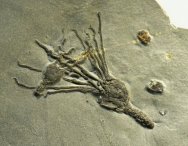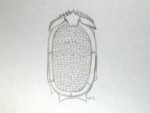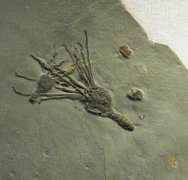Ctenocystis
sp (possibly utahensis)
Phylum Echinodermata,
Ctenocystoidea
Gogia spiralis
Echinodermata; Eocrinoidea
Geological
Time: Middle Cambrian
Size (25.4
mm = 1 inch): Ctenocystis 4 mm long Gogia; 19 mm by 8 mm and 40 mm
by 18 mm on a 100 mm by 95 mm matrix
Fossil Site:
Wheeler Formation, Millard County, Utah
Fossil Code:
EC106
Price: Sold
|  Description:
Coming from the Cambrian Wheeler Formation deposits of Millard
County, Utah this is an association plaque of a member of the
Ctenocystoidea, a small class of bilaterally-symmetrical stem
echinoderms and the eocrinoid Gogia.. The ismall examples are
Ctenocystis, a flattened rectangular animal covered with tesselated
plates. It derives its named from the ctenoid (comb-like) Description:
Coming from the Cambrian Wheeler Formation deposits of Millard
County, Utah this is an association plaque of a member of the
Ctenocystoidea, a small class of bilaterally-symmetrical stem
echinoderms and the eocrinoid Gogia.. The ismall examples are
Ctenocystis, a flattened rectangular animal covered with tesselated
plates. It derives its named from the ctenoid (comb-like) plates
that circled the oral opening. One researcher has postulated
that these plates were used to drag the animal along the seafloor.
Ctenocystis is found in the same quarry as Gogia, but only occupies
3 thin (5 mm) layers, offering another example of the stem-group
echinoderms to be found in the Middle Cambrian of Utah. The other
examples are Gogia spiralis, a member of the Class Eocrinoidea.
Eocrinoids (“dawn crinoids”), were among the earliest
groups of Echinoderms. They had a vase-shaped body (calyx), covered
by plates that were symmetrical and had a bifurcated brachiole,
a slender arm-like structure for food-gathering that closely
resembled those in cystoids. The early Eocrinoids were attached
to the bottom by a thick holdfast. Later members had an elongated
stalk much like the true crinoids which evolved later. Once Gogia
matured past the 4-armed stage (the species derives its name
from the spiraled arms), they added arms in such a way as to
have an odd-numbered total. plates
that circled the oral opening. One researcher has postulated
that these plates were used to drag the animal along the seafloor.
Ctenocystis is found in the same quarry as Gogia, but only occupies
3 thin (5 mm) layers, offering another example of the stem-group
echinoderms to be found in the Middle Cambrian of Utah. The other
examples are Gogia spiralis, a member of the Class Eocrinoidea.
Eocrinoids (“dawn crinoids”), were among the earliest
groups of Echinoderms. They had a vase-shaped body (calyx), covered
by plates that were symmetrical and had a bifurcated brachiole,
a slender arm-like structure for food-gathering that closely
resembled those in cystoids. The early Eocrinoids were attached
to the bottom by a thick holdfast. Later members had an elongated
stalk much like the true crinoids which evolved later. Once Gogia
matured past the 4-armed stage (the species derives its name
from the spiraled arms), they added arms in such a way as to
have an odd-numbered total.
|
|



